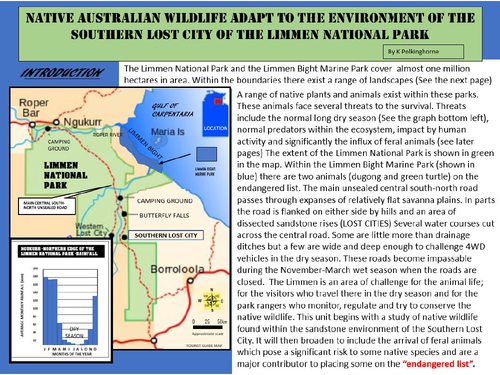

The dissected sandstone plateau of the Southern Lost City of Limmen National Park provide a distinctive habitat for a range of native wildlife. This unit has a focus on survival and adaptation to this area. The Limmen National Park was proclaimed in 2012 and research is in its early years. Those with an interest in the natural environment who ventured into the area when it was used as for cattle raising (pastoral leases) made lists of wildlife observed. In the environment within and around the Southern Lost City they began to record that certain native species were increasingly difficult to sight. Coinciding with these observations were the increasing sightings of intruding feral animals such as cane toads, feral cats and feral pigs. Their conclusion was that the feral intruders were having an affect on the survival rates of native wildlife by habitat modification and food resource reduction. Future research into this situation will shed further light on these impacts. Of particular concern were the reductions of 3 species covered in this unit. They have reached the "endangered" list and were heading for extinction within this area. Of particular concern were sightings of feral cats. Though not yet numerous in this park their numbers were likely to increase and their efficient hunting and killing skills would place native bird and small mammal species under threat. The feral cat situation is covered in another unit entitled "The feral cat menace - impact on Australian native wildlife". This unit can stand alone as an introduction to the impact of feral animals on native wildlife. It cat be used to introduce the topic of tha considerable problem caused by the increasing population and spread of feral cats which are regarded as the top predator affecting native Australian wildlife. That unit will also consider programmes carried out by the AWC (Australian Wildlife Conservancy) to conserve and protect native wildlife of Australia and avoid (if possible)adding names to the list of species that have become extinct. The worksheets (colour and black and white) are included so that hard copies can be distributed.
Something went wrong, please try again later.
Thank you so much!
Report this resourceto let us know if it violates our terms and conditions.
Our customer service team will review your report and will be in touch.
£0.00
